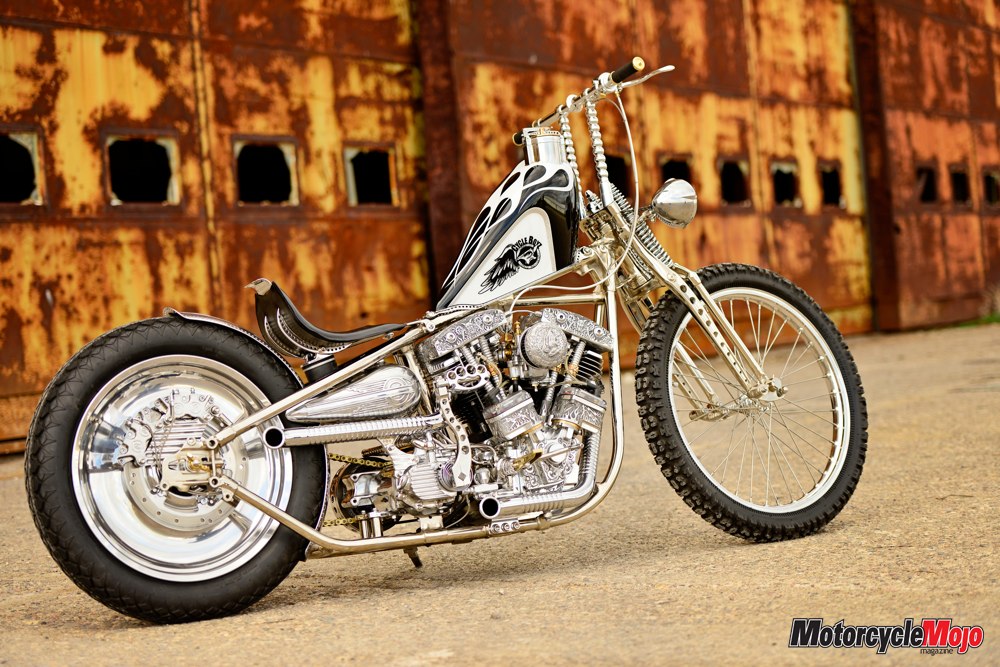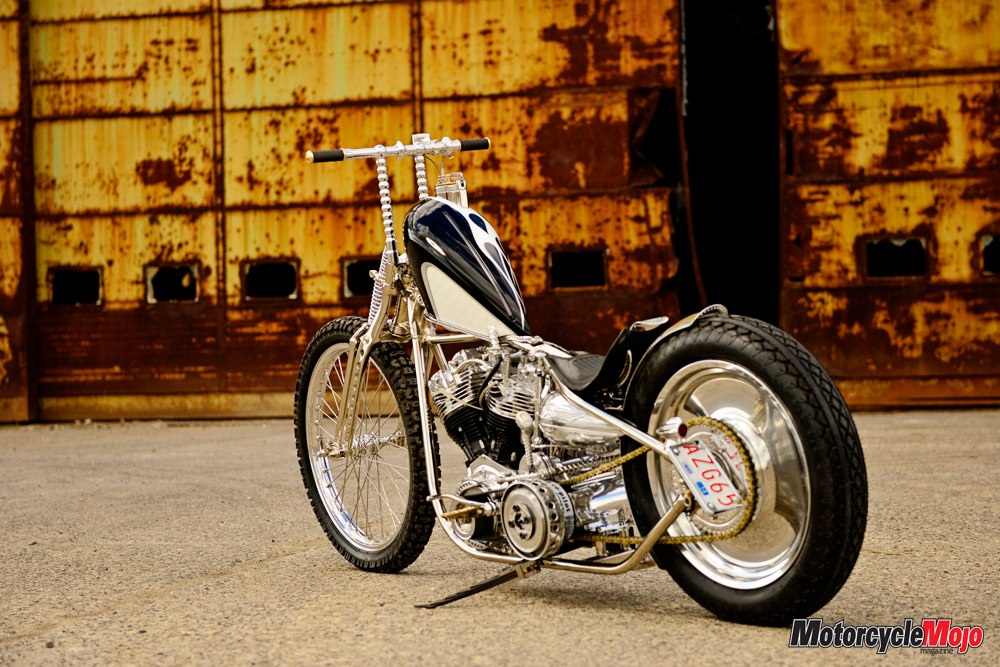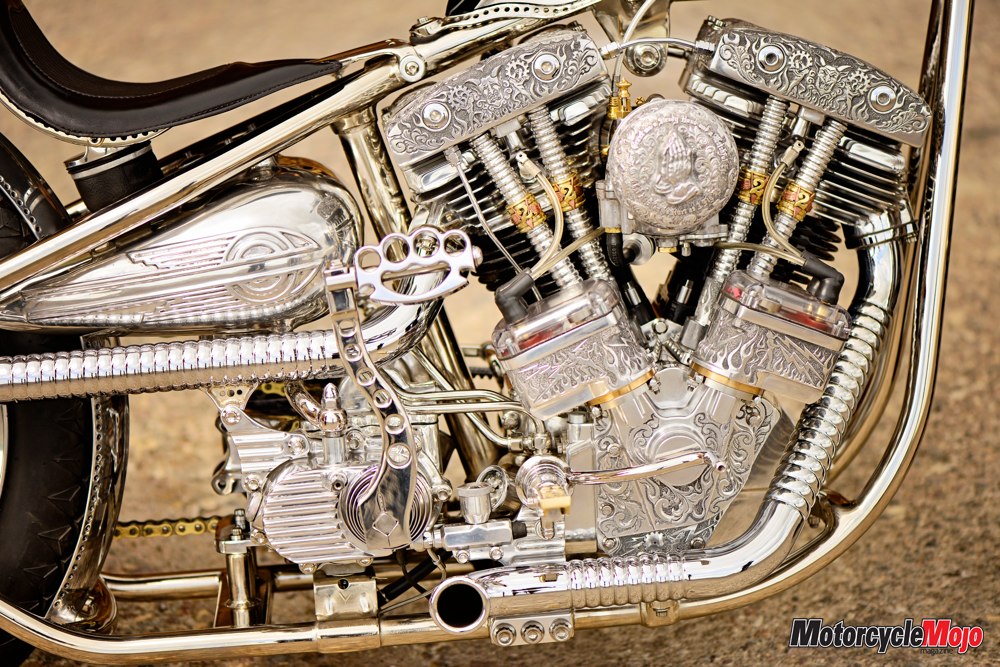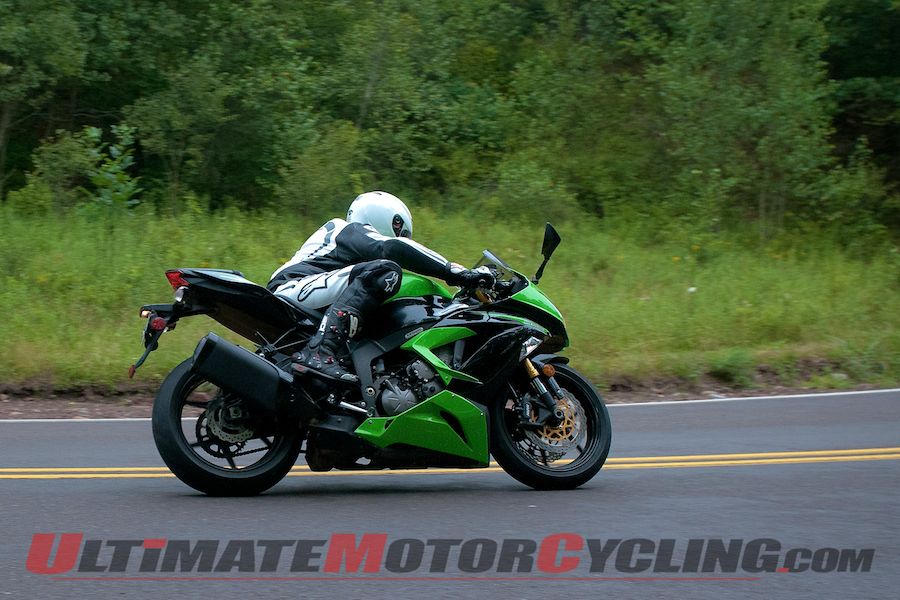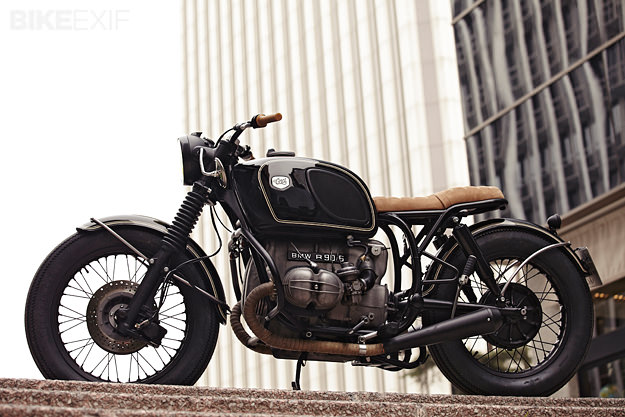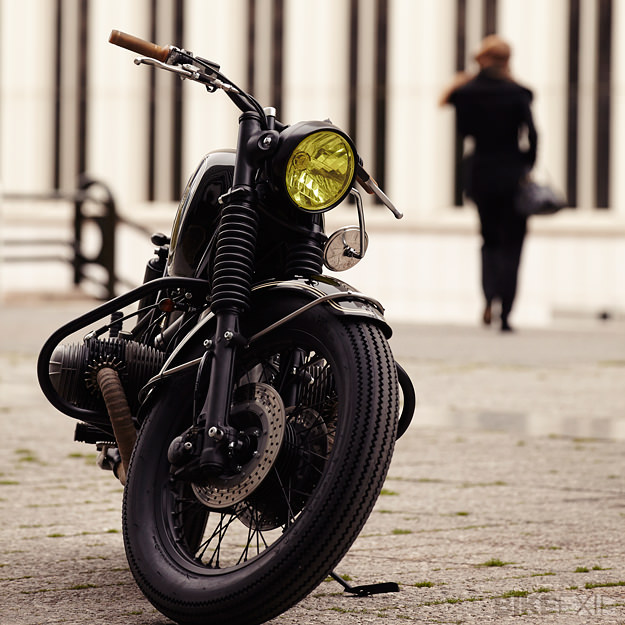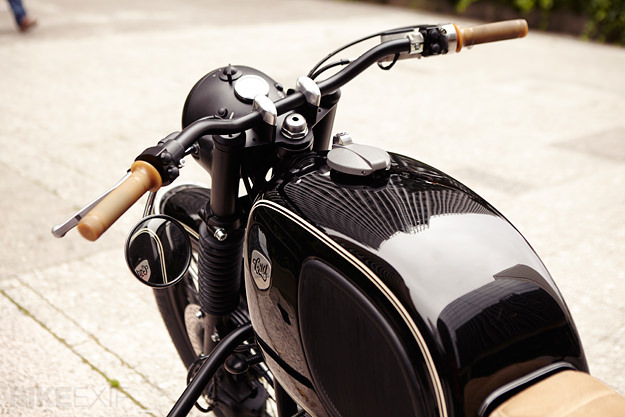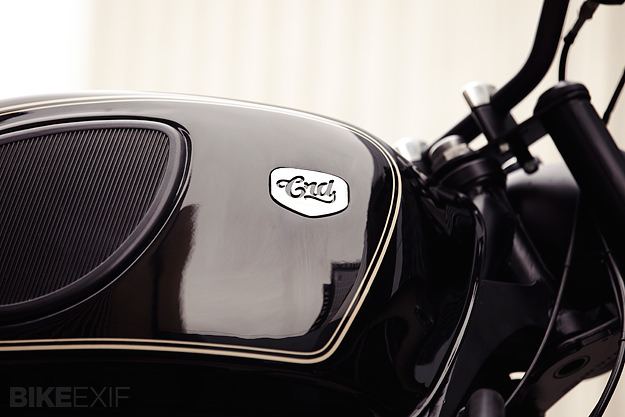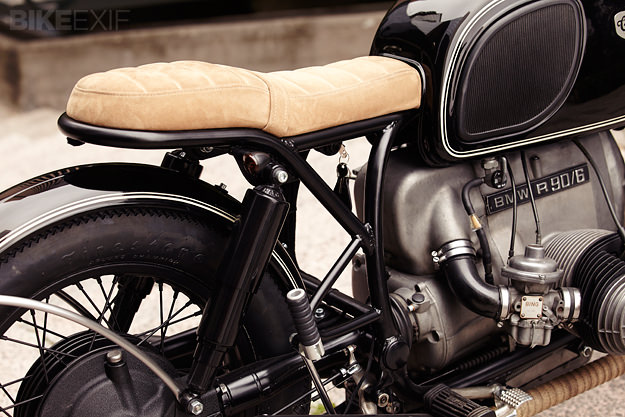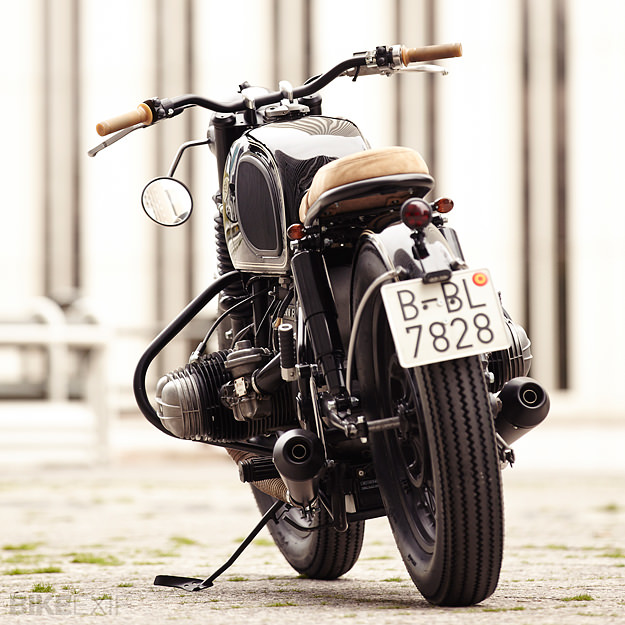The story of Lucille is long and complicated. It all started about a decade ago, shortly after Brent and Derek Law started Cycle Boyz in Brandon, Manitoba. Brent sold his Shovelhead to a friend in order to fund their first shop build. Time marched on, and the bike changed hands again. Mike Ball bought that Shovelhead, but eventually traded it back to Brent on a deal for another bike. Getting his hands back on his original Shovel meant a lot to Brent, and he vowed to fix it up and never sell it again. After building that Shovel into a show bike, Mike re-entered the picture and decided he wanted it back – but Brent wouldn’t let it go this time. Wanting to keep his customer happy, Brent found a bone-stock 1979 FLH for Mike, and soon after, it was stripped, with plans to create a no-holds-barred showstopper. Trusting in the abilities of the staff at the shop, Mike gave Cycle Boyz free rein to build a rideable showpiece.
First, the stock frame was modified to create the rigid rear end. Cycle Boyz prefer to keep their frames looking original, so they used stock-style castings from Hardtail Choppers for the axle plates.
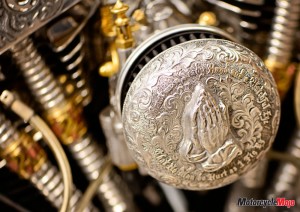 While
the frame was being rebuilt, Derek tore into the engine for a refresh.
Even though it seemed to be a good runner, Mike wanted to go big. Good
thing. Derek found plenty of problems with the internals, including
cracked heads, so he overhauled the engine as a 93-cubic-inch with new
S&S internals and heads. Next, Derek gutted the tranny and replaced
everything inside the stock H-D cases with Andrews gears and shafts.
While
the frame was being rebuilt, Derek tore into the engine for a refresh.
Even though it seemed to be a good runner, Mike wanted to go big. Good
thing. Derek found plenty of problems with the internals, including
cracked heads, so he overhauled the engine as a 93-cubic-inch with new
S&S internals and heads. Next, Derek gutted the tranny and replaced
everything inside the stock H-D cases with Andrews gears and shafts.Engine cases were sent out to Heather at New-line Engraving. Her artistic and engraving talents are second to none. Brent can’t wait to see her finished products when they return to the shop .
“She’s never let us down,” Brent said. “And she’s like my mom, she’ll send baking out with my parts, she’s awesome.”
The oil bag was made from two cast halves of a small fuel tank that Brent originally bought with the idea to one day make a tank, but it would be far too small to be practical. He reshaped the halves and welded a strip between them to fit the frame, and incorporated a pocket underneath to hold a spin-on oil filter.
The rear wheel is a reworked front V-Rod wheel with a Cycle Boyz–made sprocket and brake mounts. Up front is a 23-inch speedway hoop laced to a spool hub, but because of a lack of 23-inch street rubber, Brent had to resort to using a knobby tire. He understands that a skinny 23-inch tire should be released shortly, and it will replace the knobby.
The lack of a brake on the front helps to keep the front wheel clean, but doesn’t aid in stopping, so an extra caliper was added to the rear. One caliper is tied to the front brake lever, while the other is linked to the rear brake pedal. Since the bike has a foot clutch, this configuration enables a brake application even if the right foot is on the ground while the left foot is busy with the clutch.
With the engine electrics fed by dual Morris magnetos, the only other electrical requirement is the headlight and taillight. Brent and Derek didn’t want a battery taking up valuable space, so instead, they knocked three of the six magnets off of the H-D rotor to decrease the amount of AC current it produced, and then ran a snowmobile regulator/rectifier to dump any extra power. After trying a couple of different stators, they found the proper combination to run just the headlight and taillight without using a battery eliminator or capacitor. A lot of trial and error, but the end result was just a few bits of wire.
The final combination of skillfully made parts and talent paid off. The bike was entered into five ride-in shows during the 2013 Sturgis Rally, and Lucille won first place in every class it was entered in, including two out of three Best in Show awards. But the cherry on top was taking top honours in the Modified Harley class at the Ultimate Builder’s Show, where the other builders are the judges.
It’s always a nice feather in your cap when your peers, those with bikes in the same show, determine that yours is best
| Owner: | Mike Ball |
| Make: | Harley-Davidson |
| Model: | FLH |
| Builder: | Cycle Boyz Customs |
| Time to Build: | Two years |
| Name of Bike: | Lucille |
| Engine | |
| Year: | 1979 |
| Builder: | Cycle Boyz |
| Displacement: | 93” |
| Cases: | H-D |
| Heads: | S&S |
| Lower End: | S&S |
| Carburetor: | S&S Super E |
| Air Cleaner: | Cycle Boyz |
| Ignition: | Morris Magneto |
| Exhaust: | Cycle Boyz |
| Transmission | |
| Year: | 1979 |
| Builder: | Cycle Boyz |
| Type: | 4-speed ratchet top |
| Case: | H-D |
| Clutch: | BDL |
| Primary Drive: | BDL 1.5″ |
| Frame | |
| Year: | 1979 |
| Builder: | H-D/Cycle Boyz |
| Type: | Swingarm – now rigid |
| Rake: | Stock |
| Modifications: | Hard tail, windowed neck. |
| Front End | |
| Year: | 2013 |
| Builder: | WW Cycles |
| Type: | VL Springer |
| Triple Trees: | WW Cycles |
| Modifications: | Shortened, drilled, nickel-plated. |
| Finishings | |
| Painting: | Brian Fidler, Jamie Hertzog. |
| Chroming: | House of Silver, Chrome Pit |
| Wheels | |
| Front Size: | 23” x 1.6” |
| Builder/Manufacturer: | Cycle Boyz |
| Tire Make and size: | Bridgestone 3.00-23 |
| Rear Size: | 19” x 3.5” |
| Builder/Manufacturer: | Harley-Davidson |
| Tire Make and size: | Coker 4.00-19 |
| Essentials | |
| Gas Tank: | Cycle Boyz |
| Oil Tank: | Cycle Boyz |
| Fenders: | Cycle Boyz |
| Seat: | Cycle Boyz/Union Speed |
| Handlebars: | Cycle Boyz /Pearson Customs |
| Headlight: | TT Co. |
| Taillight: | Belmit/ Cycle Boyz |
Extras/Things to add/ People to mention: We’d like to thank
Mike Ball for the patience and free rein to do this bike our way. Our
right hand man Myles Green for the countless hours and dedication seeing
this project through. Fidler for the amazing paint and, of course,
Heather New for the unbelievable engraving.
first appeared onwww.motorcyclemojo.com
